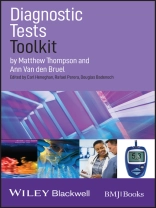Diagnostic Tests Toolkit
Diagnostic Tests Toolkit
Finding the evidence for diagnostic tests
Establishing an evidence-based methodology to assess the effectiveness of diagnostic tests has posed problems for many years. Now that the framework is in place health professionals can find and appraise the evidence for themselves. With Diagnostic Tests Toolkit clinicians and junior researchers can interpret the evidence for the effectiveness of different types of diagnostic tests, or develop their own research using the successful ‘step-by-step’ format of the Toolkit series. Written by renowned clinical researchers, this is the first basic guide to evidence-based diagnosis. It is equally valuable to starters in clinical research and those needing a quick refresher on the core elements of evidence-based diagnosis.
表中的内容
Acknowledgements, viii
Introduction, ix
Chapter 1 Diagnosis in evidence-based medicine, 1
Diagnosis and screening, 1
Screening, 3
Symptoms, 3
Signs and elicited symptoms, 4
Bedside or point-of-care testing, 4
Laboratory tests, 4
Basic structure of studies of diagnostic tests, 4
Further reading, 5
Chapter 2 Evaluating new diagnostic tests, 6
Technical accuracy (‘Can it work?’), 7
Place in the clinical pathway (‘Where does the test fi tin the existing clinical pathway?’), 9
Ability of the test to diagnose or exclude the target condition(‘Does it work in patients?’), 10
The effect of the test on patient outcomes (‘Are patientsbetter off?’), 12
Cost-effectiveness (‘Is it worth the cost?’), 14
Further reading, 15
Chapter 3 Asking an answerable clinical question, 16
Defining a clinical question for diagnostic tests – PIRT, 16
Further reading, 17
Chapter 4 Finding the evidence: how to get the most from yoursearching, 18
Combine textwords and thesaurus, 20
Search filters for diagnostic accuracy studies, 20
Further reading, 21
Chapter 5 Selecting relevant studies, 22
Selecting relevant studies, 22
Assessing validity, 23
What is the difference between bias andvariability in diagnostic studies?, 23
The ‘ideal’ diagnostic study, 24
Flow charts of patients, 24
Chapter 6 Sources of bias in diagnostic studies, 26
Spectrum bias (also known as selection bias), 26
Verification bias (also called referral or work-up bias), 28
Incorporation bias, 29
Observer (or test review bias) bias, 30
Differential reference bias (double gold standard), 31
What are the effects of the different design-related biases?, 32
Further reading, 33
Chapter 7 Measures of discrimination of diagnostic tests, 34
Two by two tables, 34
Outcome measures, 36
Which measure should you use and why?, 38
The effect of prevalence on predictive values, 40
Effect of time on diagnostic accuracy, 41
Effect of severity of the target condition on diagnosticaccuracy, 42
The referral fi lter, 42
Rules of thumb for interpreting likelihood ratios, 44
Further reading, 52
Chapter 8 Using diagnostic information in clinical practice, 53
Validity of data, 54
Problem-solving strategies that clinicians use in diagnosis, 55
Action thresholds versus testing thresholds (‘Will thetest change my management?’), 57
Methods for combining test results, 58
Multivariable analyses, 60
How are clinical prediction rules developed?, 62
How to select a prediction rule for clinical practice, 64
Further reading, 65
Chapter 9 Screening tests, 66
What are screening tests?, 66
Different types of screening, 66
Ideal study design for screening tests, 68
Over-diagnosis, 74
Further reading, 74
Chapter 10 Systematic reviews of diagnostictest accuracy studies, 75
The research question, 75
The literature search, 76
Assess the quality of individual studies included in the review, 79
Summarizing the results of diagnostic studies, 80
Combining data and interpreting meta-analyses of diagnosticstudies, 85
Acknowledgements, 88
Further reading, 88
Appendix 1 Evidence-based medicine – a glossary ofterms, 90
Appendix 2 Further reading, 96
Books, 96
Useful websites, 96
Useful journal articles, 96
Index, 98
关于作者
Matthew Thompson | Oxford Centre for Monitoring and Diagnosis, Department of Primary Care Health Sciences, University of Oxford, UK & Department of Family Medicine, Oregon Health & Science University, Portland, Oregon, USA
Ann Van den Bruel | Department of Primary Care Health Sciences, University of Oxford, Oxford, UK
Series Editors: Carl Heneghan, Centre for Evidence-Based Medicine, Oxford, UK, Rafael Perera, Department of Primary Care, University of Oxford, UK; Douglas Badenoch, Minervation Ltd, Edinburgh, UK












